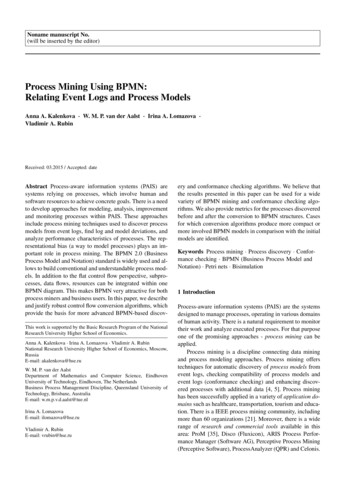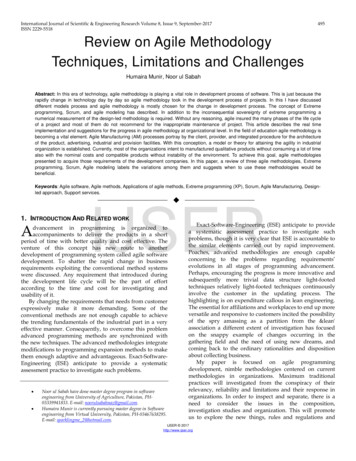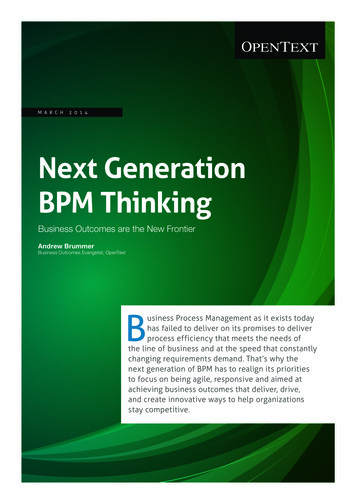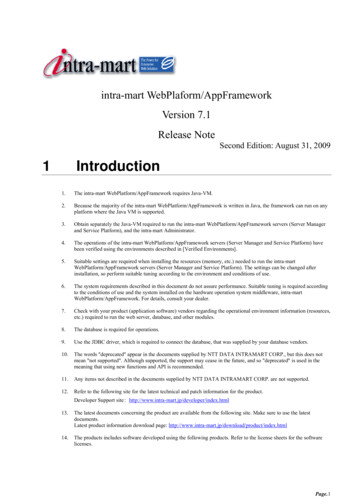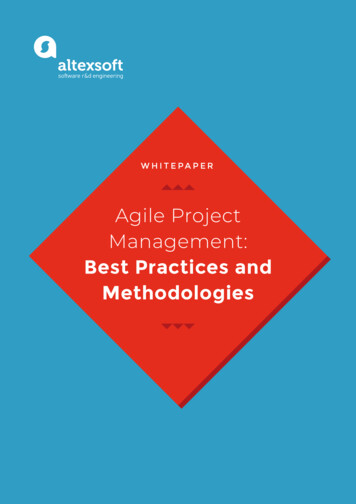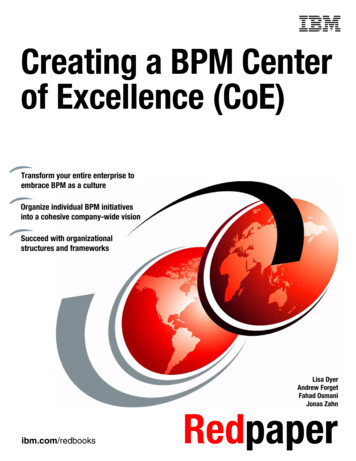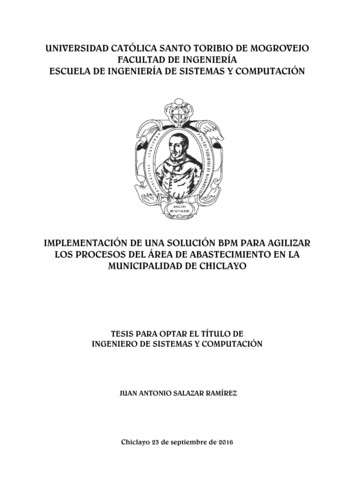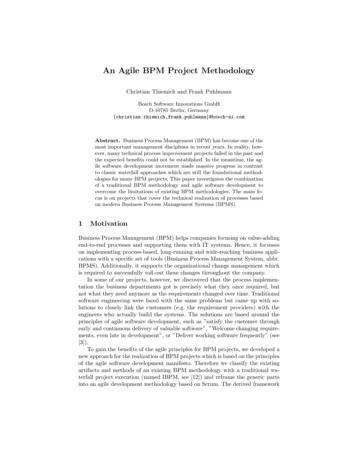
Transcription
An Agile BPM Project MethodologyChristian Thiemich and Frank PuhlmannBosch Software Innovations GmbHD-10785 Berlin, i.comAbstract. Business Process Management (BPM) has become one of themost important management disciplines in recent years. In reality, however, many technical process improvement projects failed in the past andthe expected benefits could not be established. In the meantime, the agile software development movement made massive progress in contrastto classic waterfall approaches which are still the foundational methodologies for many BPM projects. This paper investigates the combinationof a traditional BPM methodology and agile software development toovercome the limitations of existing BPM methodologies. The main focus is on projects that cover the technical realization of processes basedon modern Business Process Management Systems (BPMS).1MotivationBusiness Process Management (BPM) helps companies focusing on value-addingend-to-end processes and supporting them with IT systems. Hence, it focusseson implementing process-based, long-running and wide-reaching business applications with a specific set of tools (Business Process Management System, abbr.BPMS). Additionally, it supports the organizational change management whichis required to successfully roll-out these changes throughout the company.In some of our projects, however, we discovered that the process implementation the business departments got is precisely what they once required, butnot what they need anymore as the requirements changed over time. Traditionalsoftware engineering were faced with the same problems but came up with solutions to closely link the customers (e.g. the requirement providers) with theengineers who actually build the systems. The solutions are based around theprinciples of agile software development, such as ”satisfy the customer throughearly and continuous delivery of valuable software”, ”Welcome changing requirements, even late in development”, or ”Deliver working software frequently” (see[3]).To gain the benefits of the agile principles for BPM projects, we developed anew approach for the realization of BPM projects which is based on the principlesof the agile software development manifesto. Therefore we classify the existingartifacts and methods of an existing BPM methodology with a traditional waterfall project execution (named IBPM, see [12]) and reframe the generic partsinto an agile development methodology based on Scrum. The derived framework
-----------------------------G--------- ----------- Business--------Analysis-b--------- Componen4---------UI-Design------- --- ------------J-----------------Business--------- Technical--------Objects-b--------- iled--------Design-------5POAD ig. 1. The Integrated BPM Project Methodology Framework according to [12]builds the foundation for an agile BPM methodology that provides guidancefrom early BPM project initiatives to the final implementation.The paper is structured as follows. We start with an overview of the preliminaries in section 2, in particular IBPM as well as Scrum. Section 3 discussesthe foundations of agile BPM projects. Besides providing an adaption of theagile principles to BPM, it also provides a guideline whether a BPM projectshould be implemented with the usage of the traditional lifecycle or by an agilemethodology. Section 4 provides the core concepts of the agile BPM methodology, including a formal meta model, the agile lifecycle and key artifacts andmethods.1 Section 5 introduces a practical experience with the application ofthe agile methodology. We discuss related work in section 6 and conclude insection 7.2Preliminaries: IBPM and ScrumThis section introduces the basics of the Integrated BPM Project Methodology(IBPM) [12] and the Scrum software development framework. Both approacheshave different purposes. While IBPM has a strong focus on analysis and design,Scrum delivers a holistic approach of how to get requirements implemented.IBPM furthermore provides best practices and artifacts to capture and discussbusiness requirements.2.1The Integrated BPM Project MethodologyThe Integrated BPM Project Methodology enables BPM projects to be accomplished in a structured manner. The authors introduce different characteristicsof BPM projects that are distinct to pure software development projects. BPM1A complete description of the agile BPM methodology has been published as a Master Thesis (In German), available online at http://frapu.de/pdf/thiemich2012.pdf.
IBPM Overview3IBPM Project Approach Sequential approach withtwo design iterationsTop-Down and from left torightFocus on requirementsspecificationDefines roles and theirresponsibilitiesPlanningPO-ASO-APO-D ISO-D IPO-D IISO-D IIImplementationFig. 2. IBPM Project Approach according to [12]21projects are to a large degree organizational projects. The challenge is to separate process flow and decision logic from software development aspects such asfunctions, thus establishing a well aligned and loosely coupled service-orientedBosch Software Innovations architecture.Inubit AG, BPM Methodik 16.10.2012 Bosch Software InnovationsGmbH 2012. Alle Rechte behindvorbehalten, auchbzgl. jeder was a desire to increase quality and efficiencyThe motivationIBPMVerfügung, Verwertung, Reproduktion, Bearbeitung, Weitergabe sowie für den Fall von Schutzrechtsanmeldungen.as well as to reduce risks and costs by enabling people to ask the right questionsand deliver the right artifacts at the right time. For this purpose IBPM uses bestpractices and consists of the following three core components: IBPM Framework,IBPM Pattern Catalogue, IBPM Project Approach.Preliminary 1 (IBPM Framework).The IBPM Framework, shown infigure 1, defines ten thematic pillars, which combine the most important aspectsfrom the process-oriented and the service-oriented perspective in a BPM project.Both perspectives are represented by five columns. Given that the process modelis based on BPMN, it is the leading artifact for the process-oriented perspective.Additional pillars include Organization and Roles (B), User Tasks (C), BusinessRules (D) as well as Process Monitoring (E). The same idea can be applied tothe pillars in the service perspective. The Componentization (F) contains theleading artifact represented as an SOA-Map as well as four more refining pillars.The Framework is additionally based on five different levels of detail (Planning,Analysis, Business Design, Implementation Design and Implementation). Theresulting matrix allows the structured discussion of artifacts and correspondingrequirements.Preliminary 2 (IBPM Pattern Catalogue). The IBPM Pattern Catalogueis based on best practices and provides project conventions for eight differentaspects with predefined patterns. The patterns include BPMN modeling guidelines, UI templates, or patterns covering change management.Preliminary 3 (IBPM Project Approach). The IBPM Project Approach(figure 2) is based on a waterfall approach and introduces different project phases(Planning, Analysis, Business Design, Implementation Design, Implementation)
4Daily ScrumMeetingSprintPlanningSprint ReviewSprintRetrospective24 ksFig. 3. The Scrum Development ProcessBosch Software Innovations29Inubit AG, BPM Methodik 16.10.2012 Bosch Software Innovations GmbH 2012. Alle Rechte vorbehalten, auch bzgl. jederVerfügung, Verwertung, Reproduktion, Bearbeitung, Weitergabe sowie für den Fall von Schutzrechtsanmeldungen.and working packages, focusing either on Processes or Services with a strongemphasis on the Analysis and Design of a BPM project. IBPM splits the design phase into the Business Design and the Implementation Design. ComparingIBPM to generic project approaches, IBPM adds value by defining BPM-specifictasks, roles and artifacts.2.2The Scrum Software Development FrameworkScrum (see e.g. [10],[15]) is a lightweight development framework, which is easy tounderstand and provides defined roles and processes. Even though the frameworkwas born the early 1990s for software development purposes, other disciplines,including general management, have adapted it more and more [4]. It representsthe Agile Manifesto2 and the associated principles by focusing on collaborationand interaction to satisfy the customer. Scrum is based on empirical process control theory and utilizes an iterative, incremental approach to control risks andoptimize predictability. The main goal is to develop potentially releasable product increments in short, consistent and time-boxed iterations, so-called sprints.Scrum is based around three roles (Product Owner, Scrum Master, Team),four meetings (Sprint Planning, Daily Scrum, Sprint Review and Sprint Retrospective) and three artifacts (Product Backlog, Sprint Backlog, Product Increment). We introduce the product backlog, followed by the other artifacts androles based on the meetings as shown in figure 3.Preliminary 4 (Product Backlog).A ”Product Backlog” describes therequirements for a product prioritized by their business values. In addition eachentry in a Backlog is estimated (according to an abstract effort metrics basedon ”Story Points”) and has a set of acceptance criteria.Preliminary 5 (Sprint Planning). Within the first part of a ”Sprint Planning” the ”Product Owner” presents his goal for the following sprint and hispriorities. The team will estimate the presented items and depending on thevelocity (e.g. how many ”Story Points” a team can currently implement in a2See http://agilemanifesto.org/
5predefined time frame), a certain amount of ”Backlog Items” are selected forthe sprint. In the second part of the ”Sprint Planning” those requirements arebroken down into ”Tasks” which result as entries in the ”Sprint Backlog”.Preliminary 6 (Daily Scrum). Over a predefined length of a sprint (usually2-4 weeks) the Team will meet daily for the ”Daily Scrum” to synchronize thecurrent work and especially the problems (so-called impediments). The ”ScrumMaster” is responsible for solving those impediments as quickly as possible.Preliminary 7 (Sprint Review). At the end of a ”Sprint” the ”Team”,the ”Scrum Master” and the ”Product Owner” will meet again for the ”SprintReview”. Based on the requirements and their predefined acceptance criteria the”Product Owner” will approve the requirements in the live system.Preliminary 8 (Sprint Retrospective).The last meeting of a ”Sprint”is the ”Retrospective” where the ”Team” and the ”Scrum Master” (sometimesincluding the ”Product Owner”) reflect the result of the ”Sprint” and definetasks to improve their Scrum process.Scrum has a number of variants with additional steps or artifacts like Backlog Grooming, a Definition of Ready and a Definition of Done. The BacklogGrooming establishes a new meeting that helps the Product Owner to maintainhis Product Backlog. He can get the assistance of the Team to make sure thatthe items in his Product Backlog are ready corresponding to the Definition ofReady. The Definition of Done is used to define general criteria which are neededin order for each requirement to be approved by the Product Owner.3Foundations of Agile BPM ProjectsThis section discusses selected agile principles and how they affect BPM projects.We start by introducing the foundation of agile BPM projects by comparing theidea of BPM and the definition of a project. The idea behind BPM is to providesustainable and continuous improvements, whereas projects are intended to beunique and to have defined goals.From our experience, most BPM improvements are motivated by a projectand are not continuous at all. BPM aims to make the business processes flexibleand to improve them continuously. Even though agile projects are still projects,they have certain advantages in combination with BPM. They lead to an inevitable flexibility for BPM projects which embraces and welcomes changes.Additionally, when most projects start, their goal is often not exactly definedat a detailed levels. Agile approaches cut off the overhead of a multiple-monthanalysis and design phase and deliver visible results in early phases of the project.Best Practice 1 (Motivate the different approaches using the ”MagicTriangle”). Use the ”Magic Triangle”, shown in figure 4, to explain the idea ofthe paradigm shift that accompanied an agile development approach. While theclassic waterfall approach has a fixed project scope, it only delivers assumptionson time and budget. Turning the triangle to agile, in contrast, offers a fixed timeand budget, but no limitation or restriction on the scope.
6Planning TimeBudgetScopeFig. 4. Comparing the magic triangleBosch Software Innovations28Inubit AG, BPM Methodik 16.10.2012 Bosch Software Innovations GmbH 2012. Alle Rechte vorbehalten, auch bzgl. jederVerfügung, Verwertung, Reproduktion, Bearbeitung, Weitergabe sowie für den Fall von Schutzrechtsanmeldungen.Until recently, a project without a clearly defined scope was not acceptable.Nowadays it is recognized that long-running projects with a fixed scope areoften not successful and do not lead to end-user acceptance. To overcome thisissue, the foundation of agile BPM projects is based on an adaption of the AgileManifesto and its principles. In the following, the most relevant principles behindthe Agile Manifesto are reflected from the perspective of a BPM project. We citethe principles according to [5]:Principle 1. Our highest priority is to satisfy the customer through early andcontinuous delivery of valuable software.A number of BPM projects have a long analysis and design phase, includinglate presentation of visible results. Thus, the customer is not able to realign thedirection of the project at appropriate times, leading to no continuous deliveryat all. BPM projects are often accompanied by coarse-grained requirements.Since BPM and the agile approaches have similar preconditions, further researchis necessary on how they fit together. Again, the idea of BPM is that of asustainable improvement and support of the business’ processes and not theaccomplishment of a single project. This is a significant problem that is addressedvia agile BPM projects.Principle 2. Welcome changing requirements, even late in development. Agileprocesses harness change for the customer’s competitive advantage.Why do companies engage in BPM? They expect competitive advantagesand want to reduce the time-to-market of their innovations and improvements.Our experience has shown that BPM projects are often delayed due to changingrequirements. Agile methods welcome changes to satisfy customer requirements,which have evolved over time. This refines the process implementation, channeling it into the direction to help fulfill the customer’s needs.Principle 3. Deliver working software frequently, from a couple of weeks to acouple of months, with a preference towards the shorter timescale.This principle raises the question, ’what does working software mean for aBPM project?’ Is it only the ”living” process running in the BPMS or does itmean we have rolled out the process throughout the company, including trainingand documentation? A complete rollout cannot be achieved in one single sprint.In case of a technical BPM project we need to deliver a working process in ourBPMS frequently. Depending on the project, we might have multiple releases
7Fig. 5. Project parametersevery 5–10 sprints. In this case it is important to insure that the whole lifecycleof a process has been completed (incl. test/rollout/training).Principle 4. Business professionals and developers must work together on adaily basis throughout the project.One of the major benefits of agile software development approaches is thatthey are run in short and frequent iterations. This enables a higher transparencyfor both sides. Problems become visible earlier than in classic approaches andcan be addressed directly. Business professionals are often working on multipleprojects at the same time. This leads to a problem regarding their availabilityand focus on one single project. In BPM projects, the business professionals needto be closely integrated, since the project is not only about changing softwarebut also about organizational changes.Principle 5.Continuous attention to technical excellence and good designenhances agility.Besides needing a well-designed architecture, the technical implementationof a business process might differ from the business processes model. Thereforesynchronization is needed. At this point, discussions often arise as to whetherthe process model or the (existing) technical implementation is leading. Fromour point of view, the process model should be the leading artifact. Nevertheless,to succeed with agile BPM projects it is necessary to focus on architecture first.An advantage of using modern BPMS is that there is a common base on whichreference architectures can be used as a starting point for new projects.Principle 6. Simplicity—the art of maximizing the amount of work not done—is essential.When business people and IT people work together, it is important to keep itsimple. The focus should always be on a minimum valuable process. That meansthat the details are only needed for the requirements that will be implementedin the next 2–3 sprints. By doing so, the approach stays conform to the agileprinciples that value generating business value over documentation.
8ProjectReleaseIdea for nt 0 Define targetparameters Create project idea Define projectstart/end Identify Stakeholder Evaluate BPMMaturity Define sprint length Create initial releaseplan Establish architecturevision Build team Define Definition ofDone & Definition ofReady Identify initialrequirements Define initialarchitecture Setup projectenvironment Stakeholder QuickCheck ArchitectureBlueprinting SOA Quick-Check Skill Analysis IBPM Quick-CheckLevel 1 IBPM Quick-CheckLevel 2&3 Story Mapping IBPM Quick-Check Level 2&3 IBPM Quick-Check Level 4 Story Mapping Project Idea List of Stakeholder Sprint Backlog Process Increment Story MapArchitecture VisionSOA-MAPFirst ReleaseplanSkillmatrixDef. of DoneDef. of ReadyProcess BacklogStory MapReleaseSprintSprint 1-nRefine process backlogPlan sprintDefine tasksImplement requirementsGet stakeholder feedbackControl project progressRun retrospectiveSprintSprintSprintReleasesprint Append Release Notes Train IT operations andend users Integration tests Finish Documentation Training documents Release Notes DocumentationFig. 6. Agile BPM Framework OverviewAll discussed principles have their impact on a BPM project. In most cases,it is not possible to stay conform to all of them.Best Practice 2 (Parameters for Agile or Classic Project Approaches).Evaluate the parameters shown in figure 5 to decide whether you should tendtowards executing your project in an agile or more classic (waterfall)-orientedapproach.4An Agile BPM MethodologySince IBPM and Scrum are suitable methods for their purpose, the missinglink is a value-adding combination of both frameworks. The goal of the currentsection is to combine BPM and Scrum to introduce a flexible framework for agileBPM projects. The proposed framework consists of three core aspects: ”Projectapproach”, ”Artifacts”, and ”Methods”. It enhances the reflected adaption ofagile principles in BPM projects. Our focus is on the technical implementationof process-centric projects that are realized based on BPMS.Agile BPM projects can be divided into the phases and types of sprintsshown in figure 6. As discussed, we differentiate between artifacts, methods, andactivities in each phase. Before a project starts, it must be scoped. Afterwards,the project kick-off starts the project and is followed by an adjustable number ofsprints, until the project goal is achieved. Depending on the project, the numberof releases will vary.At customer sites, the agile life cycle often leads to a discussion regardingmodeling vs. implementation. This is one of the central differences between tra-
9Fig. 7. Agile BPM Meta Modelditional agile software development projects and BPM projects. So, how doesthe documentation and modeling of business processes fit into the idea of agilesoftware development? Though it is obvious that the code itself is a kind of documentation, how can we argue the value of business process models? Since a BPMproject is mostly running on different abstraction levels (from management, business professionals and IT), we need to clarify a language that is understood byboth worlds. A process model helps to communicate the needs of the businesspeople to the IT. Furthermore, a modern BPMS allows the implementation ofthe processes based on their models.Best Practice 3 (Clarify Modeling vs. Implementation). We believethat in a BPM project, both—the process model and the implementation—generate business value. Furthermore, BPM projects are often connected withorganizational change that is based and communicated using the different models.4.1Agile BPM Meta ModelGiven that a process model is adding value to the project and needs to be specified before the process can be implemented, we generate additional dependenciesthat have to be managed. A common problem in a software development projectusing Scrum and User Stories is that the big picture or strategic fit is often lost.The combination of IBPM and Scrum in an agile BPM project helps to keep thisbig picture. Therefore several of methods and artifacts are used in our approach.
10In the following paragraphs, we will give an overview and some examples tohighlight the linkage between both approaches.The meta model of our proposed approach, shown in figure 7, depicts thedifferent artifacts, methods and activities, and indicates how they are connectedwith the processes. Not all relations are shown at the given level of granularity.As can be seen, the model is divided into different main subjects, according tofigure 6. From the BPM perspective, we assume that a process has a manager, anowner and multiple participants. Processes exist in different releases. A processimprovement will be initiated with a new project, where a project has differentroles. It always has Stakeholders and depending on the project size, a projectmight consist of one or multiple teams working together. Each team, aligned tothe idea of Scrum, has its Agile BPM Master, an Agile BPM Process Owner anda 3–5 member team. We chose a different wording to highlight that those rolesneed additional competencies.The Agile BPM Process Owner is responsible for identifying the customer’sneeds. He has to extract and transfer them into appropriate requirements inthe process backlog. The prioritization and estimation of the backlog is also hisresponsibility. Besides that, he is accountable for the Return on Invest of theproject. It is necessary that he is always available for the team, in case questions and problems arise during a sprint. The Agile BPM Master takes careof the compliance to the Agile BPM Methodology, the project approach anddifferent responsibilities. He is familiar to BPM as well as agile principles andapproaches. Particularly in the early phases of the project he is the trainer andmentor for the whole project team and moderates the meetings. He is the firstcontact person in case of any ambiguity and for problems that may threaten thetarget achievements. The team has the same role it has in Scrum. Since it is aBPM project, the required skills are different to those in software developmentprojects. Projects have multiple sprints and these sprints are associated to releases of the appropriate processes. Every sprint is run the same way. At thispoint our approach is very similar to Scrum. We decided to establish the BacklogGrooming as a mandatory activity within our projects, since we discovered outthat most of the projects use something similar to help the product owner toprepare the backlog for the next sprints.4.2Tools and TechniquesWe identified a set of tools and techniques that support us in delivering successful BPM projects. In the following we describe an excerpt of these tools andtechniques as best practices.Given that we work with user stories in our process backlog, we developedthree IBPM Quick Check Levels based on the IBPM Matrix (see figure 1) fordifferent purposes and phases (see figure 6). They establish the big picture andhelp to identify the BPM artifacts needed to achieve the defined targets andgoals. The goal of those different Quick Checks is to ask the right questionsdepending on the detail level and project approach, e.g.
11Fig. 8. IBPM Quick Check Level– ”Do we need a UI? If so, how should it look like?”– ”Are there any business rule candidates within the process?”– ”Which non-functional requirements have to be considered?”Best Practice 4 (Use the IBPM Story Check). You should use the IBPMStory Check (see figure 9) in the early phase of a new user story to identify whichsubjects and dependencies the specific story will generate. The goal is to classifynew requirements and to identify the relevant IBPM pillars. Even though it isa very simple enhancement to a story card, it helped in our projects to handledependencies and to maintain the big picture. Lets say we have a story cardthat says: ”As a purchasing agent I want to create a new purchase requisition toinitiate the purchase process”. This story will get a priority and some acceptancecriterias. In our framework, we additionally map this story into a specific processstep. In this case it is ”Create purchase requisition”. This process step can befound directly in our process model. Doing this for each user story will helpus to keep track of our end-to-end processes. A best practice is to offer threeoptions for the relevance of a specific pillar: Existing artifacts, Artifacts needed,Not needed. Based on this information we can derive specific tasks and artifactsthat have to be delivered before we can put the story into a specific sprint. Wehighly recommend to tie this method into the Definition Of Ready.Best Practice 5 (Use IBPM Quick Checks).Use the different IBPMQuick Checks levels shown in figure 10 to decide on important steps within aSprint. Since the IBPM Quick Check Level 1 is only used within the projectkickoff, the other three are used within the preparation of the next sprints. TheBacklog Grooming is supported by the Level 2 and 3. The goal is to make therequirements achievable for the team. Therefore it is necessary to identify themissing BPM artifacts. If there are any required artifacts missing, they have tobe addressed within the next sprint. Since IBPM specifies a lot of artifacts, itis not mandatory to deliver all of them. In agile BPM projects, the associateduser story is used as guideline, which artifacts should be considered. The teamdefines which of the artifacts generate value for the business and IT alignment.
12Fig. 9. IBPM Story CheckAll of these checks generate a broad set of artifacts. The artifacts are linkedto either a process, the project or methods. To handle the complexity and tounderstand their relations, we use the meta model shown in the beginning ofthis section.Best Practice 6 (Customize the Framework). Take the time to thinkabout a project-specific customization carefully. Depending on specific problemsor questions there are ways to solve issues by adapting some of our best practices.One point that sometimes leads to questions is the feasibility of requirementswithin one sprint. To make sure that any requirement that gets into a sprintcan be achieved successfully, the ”Definition of Ready” defines what needs to bedelivered prior to the realization. It is a best practice to establish the BacklogGrooming to identify the information demand for the next one or two sprints.In case the team and the Agile BPM Process Owner identifies a missing BPMartifact, there is enough time to gather or create the required information.Best Practice 7 (Use interleaved Teams for Business and TechnicalPerspectives if needed). Use interleaved parallel teams to generate ”ready”backlog items with an offset of one sprint if the stories become too complex. Oneteam represents the business perspective and shapes the requirements which willthen be implemented by the second team. This approach collides with the agileprinciples, but sometimes helps to get at least some of the concepts into a project.[14]Best Practice 8 (Adjust stories from horizontal to vertical as theproject progresses). From the product development perspective, user stories have to be vertical (e.g. one feature/activity in depth). Otherwise they can’tproduce any benefit. In contrast, BPM projects are not about product development. We recognized that there are often horizontal user stories which arepredominantly at the beginning of a project (e.g. a click-dummy of the process).They help people understand how their process will look and feel like. Afterwards it is much easier to identify which aspects must be considered vertically.
13Fig. 10. Sprint preparation with IBPM Quick ChecksAdjust the splitting of the user stories from horizontal to vertical as the projectprogr
of the agile software development manifesto. Therefore we classify the existing artifacts and methods of an existing BPM methodology with a traditional wa-terfall project execution (named IBPM, see [12]) and reframe the generic parts into an agile development methodology based on Scrum. The derived framework
